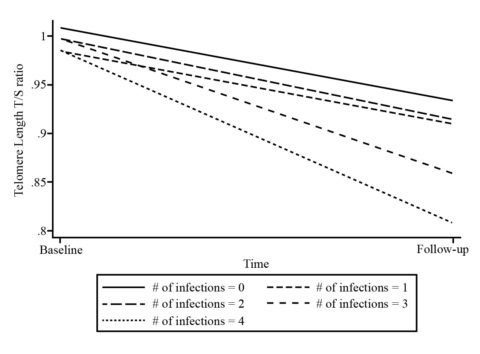Do endocrine pathways play a role?
Investigators at Kings College London report that seropositivity for CMV, Herpes simplex 1, and HHV-6 are all associated with a significant shortening of telomeres over a three-year period. Furthermore, the magnitude of the changes was great. For example, CMV seropositivity was associated with the equivalent of almost 12 years of chronological age.

Jennifer Dowd, Senior Lecturer & Associate Professor, Department of Global Health and Social Medicine, King’s College London
The length of telomeres, the tips that cap and stabilize chromosomes, is considered a marker for cellular aging since telomeres shorten slightly each time they divide, eventually leading to genomic instability and death of the cell.
Surprisingly, the investigators found that persistent herpesvirus infections were far more important than actual age when it comes to telomere attrition: age by itself only accounts for 10% of variation in leukocyte telomere length. CMV and HSV1 coinfection had the greatest impact on telomere length.
The authors believe the cause may be due to the impact of viral infection on endocrine pathways. CMV can infect and replicate in human adrenocortical cells, triggering steroidogenesis which in turn inhibits telomerase activity in CD4+ and CD8+ T-cells. Past studies have shown that greater cortisol responsivity to acute stressors is associated with telomere shortening (Steptoe 2017). Also, a previous study by the same authors suggested that CMV positivity was associated with lower telomerase activity (Dowd 2013).
Participants with >2 herpesviruses had the highest level of telomere attrition, and 4 viruses was significantly worse than 3 viruses. While HHV-6, CMV, and HSV1 were all independently associated with increased 3-year loss of leukocyte telomere length, there was no association with EBV. None of the other previously identified risk factors such as smoking, obesity, inflammation, and socioeconomic status had any impact on telomere attrition.
The investigators found 21% positive for HSV1, 47% positive for CMV, 59% positive for HHV-6, and 63% positive for EBV. The seroprevalence reported in this study was significantly lower than that reported by most (>90% for both EBV and HHV-6).

Telomere shortening based on the number of viral coinfections over 3 years. Source: Journal of Infectious Diseases
The group studied 400 healthy adults with the aim of identifying risk factors for coronary heart disease, over a period of three years. The patients were Caucasian and ranged in age from 53 to 76 years at the start of the study.
The investigators used ELISA, which is not a truly quantitative measure of antibody titers. (ELISA kits are approved only to give a “yes/no” answer on seropositivity as the output is not linear; only end titration can give a truly quantitative assessment of antibody load.)
HHV-6 is the only virus that integrates into the chromosome at the telomere, and integration is associated with short and unstable telomeres (Huang 2014).
The next step for the investigators will be to determine if these “latent” herpesvirus infections are causing the shortening and whether treating or preventing herpesvirus infections could help extend human life and mitigate disease.
Read the full paper: Dowd 2017

